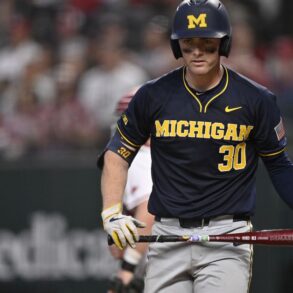Brendan Lawson’s setup at the plate is unusual. His coaches know it and sometimes chuckle when asked about the look. Lawson does the same.
It’s only funny to them because of how effective the freshman’s distinct high handset and relatively short stride are, especially at just 19 years old.
He certainly looks different at the plate, but Florida’s coaches would argue that Lawson’s results are just as unique.
“He gets on time,” Florida head coach Kevin O’Sullivan said with a grin just a few hours after Lawson hit his first-career home run on Saturday, a grand slam. “He just loads up early and gets his hands in a really good spot to hit.”
O’Sullivan and his staff have consistently spoken highly of Lawson, who is already the Gators’ starting first baseman and credits the coaching influences he’s had throughout his career for helping shape his impressive skill set.
At just 14 years old, the lefthanded hitter was working with coaches who helped him to better understand the importance of staying on-plane with his swing. Together they crafted Lawson’s creative and personalized mechanics.
“When I was younger, I always had my hands super vertical, and when I was like 14 or 15 one of my hitting coaches was like, ‘We’ve got to get your bat flatter so you’re on plane earlier and stay on plane for longer,’ because I had to be really perfect to do well,” Lawson told Baseball America. “One day, I just tried to get my hands up a little bit just messing around in batting practice, and it just felt really natural. I’ve never had trouble getting to high pitches or catching up to velo. I still put myself in a good spot. Since I was 15, that’s what I stuck with.”
The top-ranked draft prospect in Canada in 2024, Lawson has a refined game that is both polished and poised for growth. O’Sullivan, never one to hand out praise lightly, has particularly highlighted Lawson’s “exceptional” zone control, a trait that sets him apart even in the high-caliber world of college baseball. Lawson’s raw power and bat speed are also already ahead of the curve, and his natural feel for hitting speaks to an “advanced” baseball IQ.
“He’s different,” Florida senior right fielder Ty Evans said.
“You don’t find it very often,” O’Sullivan added.
It’s true. Freshmen like Lawson are historically quite rare.
Just 9.3% of all Division I players who recorded at least 100 at-bats in 2024 came from the true freshman class, a percentage that is reasonably consistent with the breakdowns over the last decade and very closely mirrors trends in recent years with rosters across the sport getting older.
| Year | True Freshmen With More Than 100 At-Bats |
| 2015 | 375 |
| 2016 | 404 |
| 2017 | 363 |
| 2018 | 340 |
| 2019 | 374 |
| 2021 | 344 |
| 2022 | 238 |
| 2023 | 270 |
| 2024 | 254 |
That small pool of true freshman players stepping into starting roles is growing increasingly competitive, though.
Coaches across the country have noted that the quality of first-year players has improved as the MLB Draft has shrunk. The way some see it, fewer elite high schoolers are bypassing college for the pros, allowing programs to land more polished and refined talent, particularly at the plate.
The shift has produced a wave of freshmen who are not only capable of making an immediate impact but are also raising the bar for what can be expected from high-caliber newcomers.
It was on full display throughout the first full week of college action in 2025. Tennessee’s Levi Clark smashed two pinch-hit home runs, including a mammoth grand slam. Texas freshman third baseman Adrian Rodriguez went 4-for-10 and has recorded more extra-base hits (seven) than singles (three) in his young career. Oregon’s Burke-Lee Mabeus went 4-for-8 with eight RBIs and a home run. There were a host of others.
“You’re seeing in today’s game that more and more guys are coming out of college ball and are flying through up to the big leagues faster than the average high school player,” Lawson said. “That went into the decision. I have a chance to get better really quick.”
That mindset has contributed to a boom in production from freshmen who emerge as contributors as first-year players.
Freshmen who recorded at least 100 at-bats in 2024 hit .284 with a .384 on-base percentage and an at-bats per home run rate of 33.3. In 2015, the first season after the NCAA made a change to low-seam baseballs, freshmen with the same criteria batted .271 with a .352 on-base percentage and home runs once per 76.7 at-bats.



RBI totals from freshmen with at least 100 at-bats are also up 28.6% since 2015.
Advances in youth coaching plus baseball’s culture of early development are a big reason.
“The last decade of baseball, we’ve been so consumed with players being maximized and being their best and showing their best at 16, 17 years old, and 20-30 years ago, that wasn’t the development plan,” Virginia head coach Brian O’Connor told Baseball America in January. “That said, kids are exposed to better baseball because of travel ball. They’re exposed to some elite-level training stuff, some strength stuff. A lot of things now that they have access to at 14 years old. When I became the coach here 21 years ago, most of the players that come into your program as a freshman had no idea what to do in the weight room. But now it’s a rarity for them to come in and not have done expensive strength training with mobility and stuff like that.”
The trend has extended beyond the high majors, too.
“The caliber of player who gets to campus now is so good,” UC Irvine head coach Ben Orloff told BA in January. “There are kids all over the country right now coming into college just really mature and ahead of the game physically.”
Added LSU head coach Jay Johnson: “We’re seeing more and more kids going to school, getting better and then starting their professional careers and having a lot of success.”
As freshman players continue to make significant contributions across college baseball, it underscores the critical importance of recruiting that group well, despite the growing influence of the transfer portal.
Teams still view high school standouts as foundational building blocks in their roster construction process.
“Everyone has their own philosophy and ours is to build with freshmen and the high school player and fill with the portal where it’s needed,” O’Sullivan said. “We were certainly more active in the portal this year than we were in year’s past but the foundation needs to be the high school player and you fill in needs accordingly.”
Those who are investing in young talent are being rewarded for it.
“We need some guys to come in and perform right away,” O’Connor said. “But, the reality is, they’re not going to be nowhere near where they’re going to be as sophomores and juniors. Right now it’s about giving them opportunities to learn and grow and that’s how you develop a program.”
This post was originally published on this site be sure to check out more of their content.







